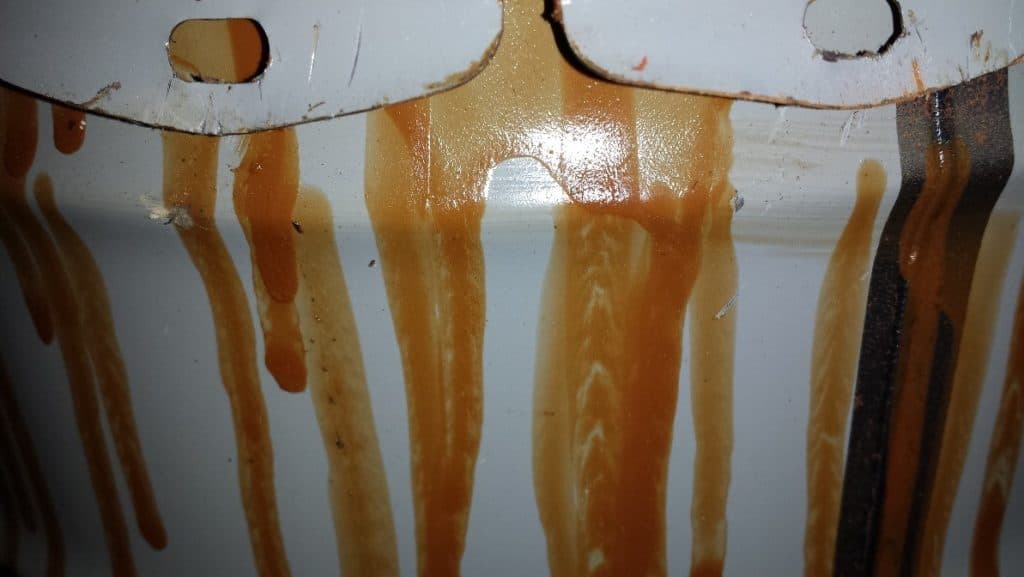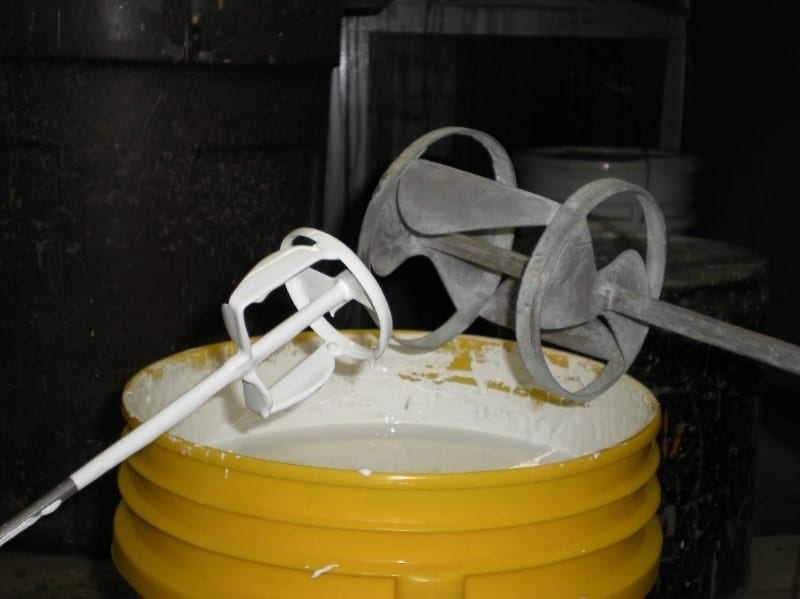Some of the common industrial coatings consist of 2 or 3 components that are mixed together just prior to use. Examples include inorganic and organic zinc, epoxy, and polyurethane. Coating manufacturers typically recommend that complete kits, rather than partial kits, always be mixed, and many specifications are explicit in preventing the mixing of partial kits. Reasons for disallowing the mixing of partial kits include:
- Mixing the components in the proper ratio is critical to the performance of the coating. If the ratio is off, curing and performance problems can occur. An incorrect ratio at some point in the mixing process, or sloppy removal of a component (Figure 1) can snowball to an incorrect ratio for the last mix. For the final mix, it is easier to dump all of the remaining material together, rather than verify that the remaining amounts are still in the correct proportions.
- It can be very challenging for workers in a production operation to take the extreme care that is necessary to carefully measure and mix partial kits. While laboratories can do this under very controlled ambient conditions and with graduated cylinders and balances, it requires a great deal of discipline and attention to details to get it right.
- When partial kits are mixed, the individual components must be thoroughly blended before extracting the material. After a portion of the coating is removed, the containers must be immediately and thoroughly sealed, otherwise volatiles in the containers can escape, effecting later mixes. In the case of urethanes, moisture in the air can create problems when sealing is inadequate.

The above concerns are compounded when dealing with a three-component material such as epoxy zinc because mixing must be done by both volume and weight. This requires the use of both graduated containers/measuring cups, and a balance/scale (which must be on a level surface to be accurate). For example, following is the mixing ratio for a common epoxy zinc primer:
1 gallon (3.78L) mixed:
Part A 0.30 gallon (1.14L)
Part B 0.30 gallon (1.14L)
Part F 22 lb. (10 Kg) Zinc Dust
Assume the contractor wants to mix one quart of paint from a 1-gallon kit for touch up. The procedure would be:
- Part A – Thoroughly mix Part A. Convert 0.3 gallons to ounces (0.3 x 128 = 38.4 oz). Measure out 25% of it or 9.6 oz. and pour it into a clean container. Completely seal the remaining Part A.
- Part B – Thoroughly mix and measure out 9.6 oz and slowly add it to Part A and blend together. Seal the remaining Part B.
- Part F – The zinc dust is portioned by weight, rather than volume. Weigh out 25% of 22 lb. or 5.5 lb. and seal the can containing the remaining zinc dust.
- Slowly sift the zinc powder into the A/B mixture while continuing agitation until it is thoroughly blended.
- Throughout the entire process, be careful that the mixing blade doesn’t throw material out of the container since such a small quantity is involved. It may even be necessary to use a smaller mixing blade (Figure 2)

As should be apparent from the above, there is a lot of opportunity for error or problems when mixing partial kits, both for each individual mix, as well as problems that can occur if the containers are not completely sealed between each of the mixes. Manufacturers supply kits in smaller sizes. Whenever possible, it is recommended that small kits be ordered for touch up.
In the end, if it is imperative that partial kits be mixed, a detailed procedure should be prepared and both the contractor’s QC and Owner’s QA witness and document each mix (stirring, proportioning, sealing of the containers, etc.).



Always a good read and useful info. Thanks Mr. Trimber. I remember working High steel in Williamsport, this was a big issue and you hit the problems right on the nail.
Yes its a practical challenge….but we have to take proper precaution while carrying out it.
As partial mixing of paints cannot be avoided in coating.
Checking PDS and with technical rep to verify mixing of partial kits is allow by the manufacture should be the first step in this process.
yes lots of time Offshore you don’t really have the choice to use smaller kits. Just have to mix it properly (measure Correctly).The problem i see mostly. when the contractor Mixes smaller portions.The tend to Grab a mixing stick or handle. Not using the air mixer.
I appreciate the detail in this article. Well written and too the point!